Let's talk loose parts! When I was in the classroom, loose parts were one of my favorite elements of the Reggio Inspired approach to implement! My hope is after reading this post, you will need no explanation as to why that was.
If you want to take your understanding of Loose Parts to the next level, dive into our new, in-depth guide and discover how these versatile materials can transform your teaching — Loose Parts Play: A Guide for Early Childhood Educators.
What are loose parts?
Loose parts are materials that can be moved all around the room and used in endless ways.
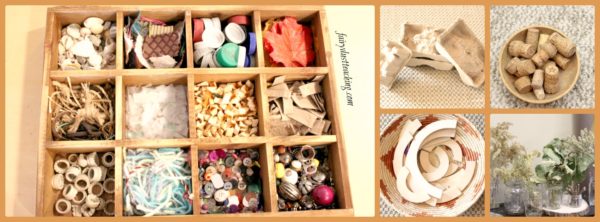
Loose Parts from Rosa Parks ECEC
There are essentially no limits to what can be used, but I have created a Loose Parts Wish List that you can download to have a list to get started.
Why Loose Parts?
The versatility of these materials provides children with virtually endless ways to create. Access to a variety of transient materials during play and exploration aids in the following:
- Problem Solving
- Engineering
- Creativity
- Concentration
- Hand-eye coordination
- Fine motor development
- Gross motor development
- Language and vocabulary building
- Mathematical thinking
- Scientific thinking
- Literacy
- Social/emotional development
- The list goes on and on…
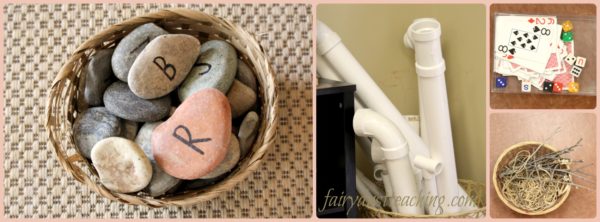
Loose Parts from Rosa Parks ECEC
Download our Loose Parts Start Up Guide in PDF format. A guide full of tips and inspiration for your Loose Parts Collection.
Gathering Loose Parts
You may be thinking, “Well that sounds great, but I don't have the funds to gather all of these materials.” That's the beauty of loose parts, they don't have to be purchased at the store! Most items you already have lying around your house. If you don't, someone in your family does or your students' families! Also, most of the local hardware stores are willing to donate materials such as pvc pipe they have cut but can't use or old wire spools. Don't be afraid to ask!
Managing Loose Parts
One of the biggest challenges I hear most teachers face or worry about is managing loose parts. My tips for this are simple:
- Start small – offer limited materials to begin with and slowly add throughout the year
- Modeling – show and practice how to get the materials out and how to put them away
- Labeling – take a pic of the material in the basket it belongs in and tape the picture where ever it is you want that basket to stay (Don't forget to take a new pic if you change materials out)
To keep things interesting, consider offering different loose parts materials following your observations of children’s play. If you follow your reflection on “what are children trying to find out” you can provide materials that support and take their investigations further. This will keep children engaged and encourage them to explore and experiment with different materials and combinations.
How Will the Children Use Loose Parts?
This is where the magic happens! You will find in your observations that each child will use the same material in a different way. A stick to one child might be a flag pole added onto their construction site, but to another it might be used to stir a pot. The beauty lies in allowing the children the freedom to explore the materials, use them as they wish (as long as they are being safe), and take them to any area of the classroom they feel the need to.
What is the Teacher's Role?
During the time the children are exploring loose parts, the teacher’s role is to serve as an observer and researcher as well as to provide language. Loose parts play is a wonderful time to observe and assess what the children are playing with and how they are playing. I kept a stack of post-it notes with me and would jot down important observations during this time. Later, I could go back and record on my Student’s Observation Record.
By incorporating loose parts play into your daily routine, you can provide children with endless opportunities for exploration, creativity, and learning. With a little creativity and planning, loose parts play can become an integral part of any early years program or daily routine.
Bonus!
I have added a short video clip of a 3-4 year old class deeply engaged in loose parts play with clay. You can watch it here.
After watching, comment with what you noticed about the learning taking place!

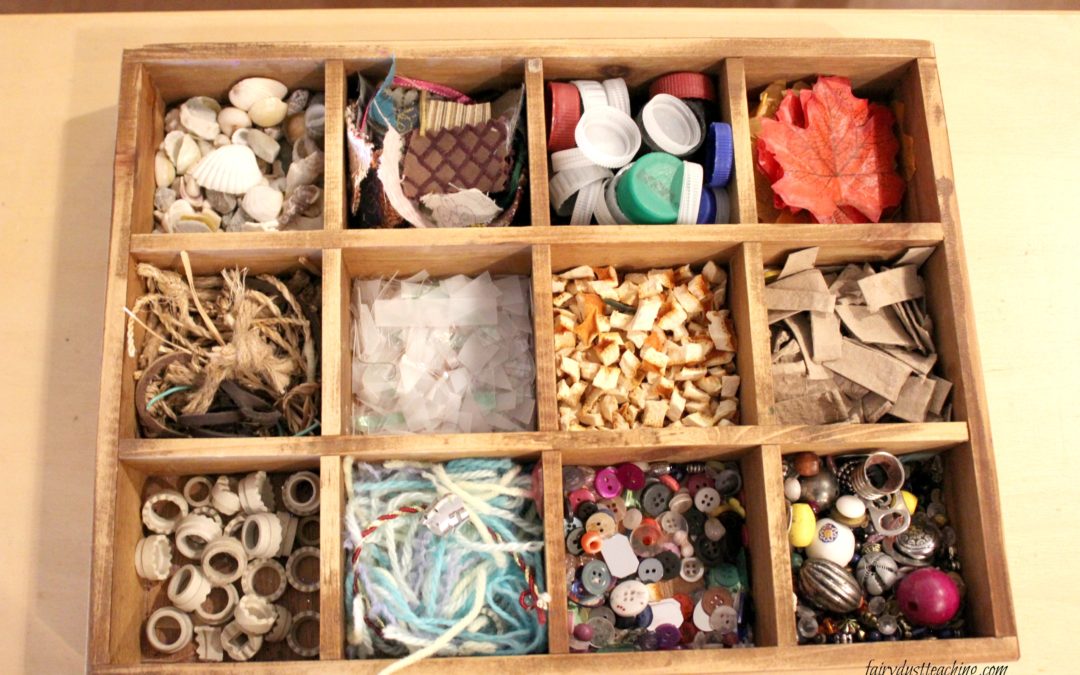
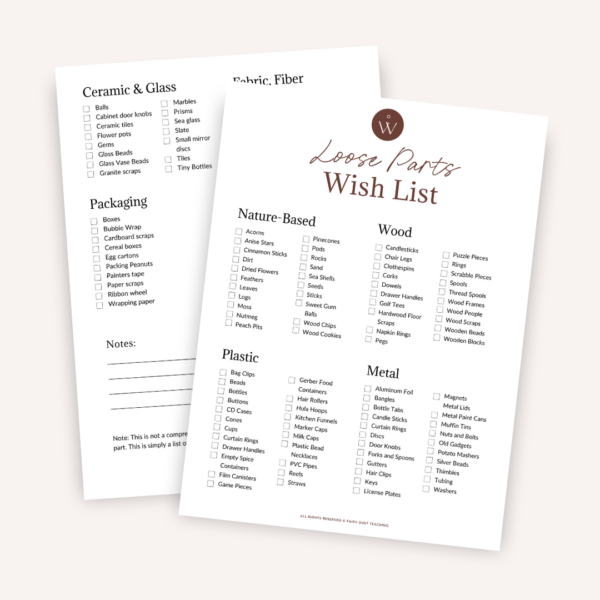
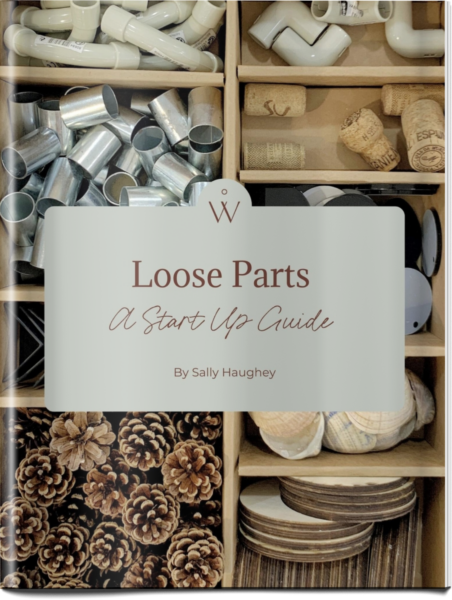
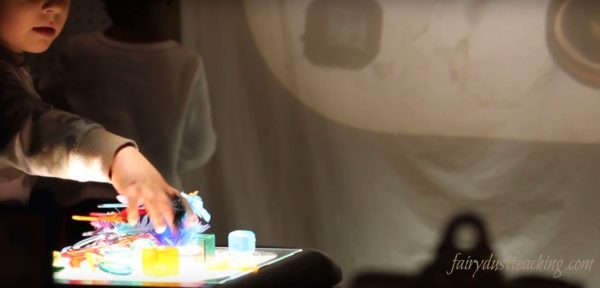
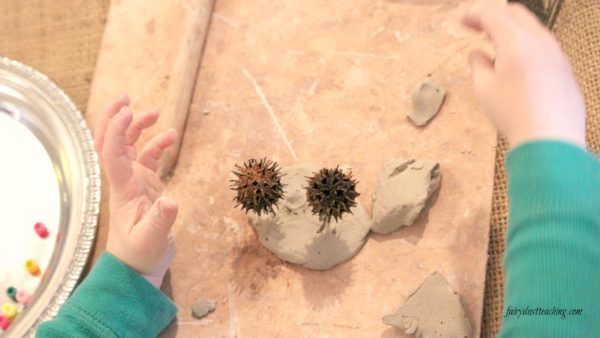
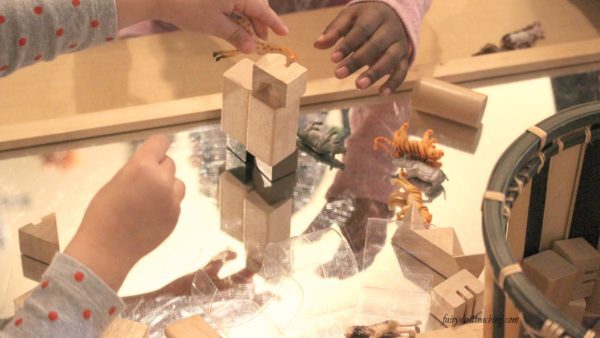
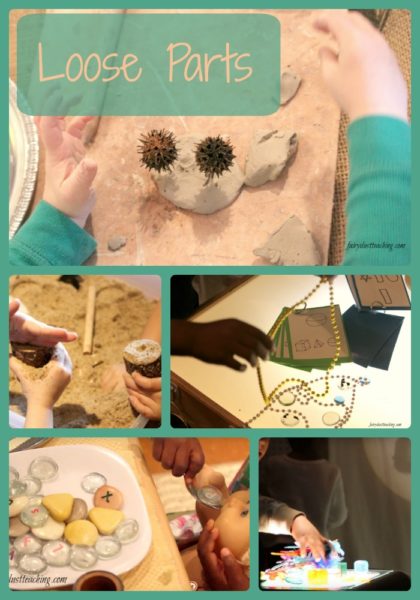

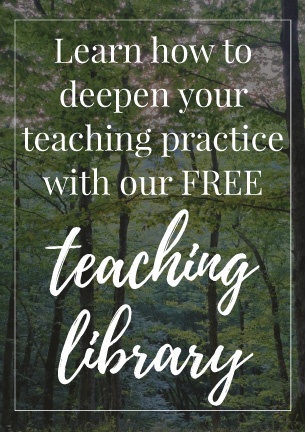
I would love a copy of the Free E Book. Thank you.
Loose parts learning has been trending in classrooms other than Reggio. Natural material are a great way to connect children with the outdoors.
I agree, Mary! Nature speaks to children and their inquisitive minds.
I would love a free e-book Thank you
Yes
gdwigwams@gmail.com
Would like the book please. Thank You.
Hi Wendy, here is a link where you can download your free copy of our e-book: https://fairydustteaching.com/provocationsebook
Love to see their imagination taking place and open discussion I use loose part as well love it
I would love to see this as well. Thanks
I collect “stuff” everywhere I go and coworkers think I’m crazy, however, I wonder how cazy teachers and educators get when it’s time to clean up and all the broken oats from pune cones are stuck in clay- what do they do with it? Throw away? Children love to mix and match and throw away. I cannot afford clay to use once and throw away. Or to use loose parts anywhere on the room and I work with 4 severe behaviors who steal from peers and break everything – to the point I put things away and Doon no one plays with things. So frustrating. How do these Regio educator’s feel at the end of a day?
We begin by introducing limited numbers of loose parts so the children are not overwhelmed. It is a gradual process. Second, things do get into the clay and that’s okay. We keep reusing it. It is not about the materials staying in perfect condition. What remains most important is the engagement and interest of the children. Baby steps and flexibility go a long way to making the daily round amazing.
I like to make my own play dough using flour, water, oil, and cream of tartar. That way it is cheap and can be thrown away after a couple of days.
interesting how the calming effect of working with clay opened up conversation about family
Is there a cheap place to get cream of tartar?
Any bulk food store, where you buy nuts, spices, flour etc by weight. Where I live it’s Bulk Barn or Scoop and Save. Cream of Tartar is waaaay cheaper than the small boxes at the grocery store.
I am looking forward to learning more about how to use loose parts in my setting!
These ideas are not only useful but also clear to let me know what is loose part and how to start!
Thanks for your share
just wondering how can get a copy of the free book. Thanks
Sign up as a subscriber and then login into the membership site. It will be under the Library section!
I have always loved the idea of loose parts in kindergarten. I’ll be trying it this year as I begin my kindergarten teaching adventure. How have you introduced loose parts into academic centers/activities?
I usually look for children’s toys at thrift stores, now I look for anything I could use as loose parts. I even have my mom in on this. Right now I have 5 storage bins full of loose parts. I think I could bug myself the queen of loose parts. 🙂
Haha! It can be a such a glorious thing to see the wide and vast space called “loose parts”!!
Hi
I have heard so much about loose parts and want to explore it further although have started collecting and incoopersting in the setting.
That is so exciting! You will be so inspired to see how loose parts capture the children’s imagination and creativity. Let us know how it goes!
I am just getting started with loose parts. I gained additional insight from the article. The video gave me information on the roles of student and teacher. It was interesting to see how each child used the clay and how the teacher supported each child’s endeavors. At the same time she validated each child’s experience with language that fostered additional ideas. I plan to use the Loose Parts Guide and the Student Checklist next year. The check list with be a wonderful addition to each child’s portfolio.
Im working in a before and after school program. We are starting to work with loose parts. I would love a copy of your loose part book if your still giving them out free. Thank you always looking for ideas on loose parts.
thank you
Isabel Bonnay
Hello Isabel,
Thank you for reaching out to us!
Here is a link where you can download your free copy of our e-book: https://fairydustteaching.com/provocationsebook
ok soom
I would love to have a copy of this book, the children at our OOSC just love making things and playing with loose parts so the book will help us as staff to bring new ideas to them
Hello Dawn,
Please scroll to the “Free E-book” section and enter your e-mail to download the book. If you have any issues please email asksally@fairydustteaching.com and we can help you download it.
Have a beautiful day!
Would love a copy of the free ebook for a resource for my Library for my Family Home Childcare Providers.
Love loose parts ….and love watching children construct with loose parts.
As an original loose parts teacher from back before there were catalogs and expensive fake toys, I am thrilled to see the interest and rejuvenation of these concepts for classrooms. Children have been longing for adults who see the child as an intentional, competent and focused learner and problem solver.
I along with our junior syndicate are beginning our journey of playbase learning and would love your free book on loose parts. We are confident teachers that are looking forward to exploring, imagination,self direction and many more. Regards Helen Korewha. The kura o The Paroa. Whakatane.
How lovely! Yes, of course! Just go here to get it: I am trying to find the Tree Branch Containers. Can you tell me where you got those or how were they made?
We also have a clean up guide: https://fairydustteaching.com/loose-parts-clean-up-guide
I would love to have the book to use for my final research project.
loved mixing the beads and pipe cleaners in with the clay –
How do you download the free book?
I love being able to introduce loose parts to my class this year. This year I have young toddlers and one 3 year-old. I am just introducing this concept I will let you know how it goes.
That is great!
Thank you for sharing
Is using glue not allowed /recommended in Loose Parts theory? Children want to create art and objects to take them home. Loose parts fall apart…
Hi Margit, great question! You can absolutely offer glue if you’d like and have the supplies to replace. I highly encourage it.
I like to use playdough too because they can take it apart and reuse it if they want and I can reuse the loose parts!
But the playdough helps the parts stick together while they’re building and creating without needing time to dry.
Tried to enter my email to get your book but it kept just sending me back to this article. I have not received anything via email. Just FYI.
Hi Julie! I’m so sorry this happened! Can you please email asksally@fairydustteaching.com so we can get an Ebook headed your way? Thank you so much 🙂
Hi there,
I found this blog post very interesting. I am currently preparing to do a presentation on loose parts at my university. I am trying to be critical and was wondering if there was any possible barriers to loose parts in primary education? Im open to any possibilities that I can investigate further.
Hi Emma! Yes, most critics of loose parts complain about 3 main things: consumption, mess, and storage. On the topic of consumption; i.e., children use them all up and they have to be replaced, my solution was lots of transient art activities and using items that I could get free or donated easily. To handle the “mess” I always set clear expectations of clean up and care for materials. These expectations were practiced over and over and reminders were given constantly. To handle the storage issue, we actually have a blog post on ways to store loose parts (https://fairydustteaching.com/2018/01/pegboards-brilliant-ideas-organizing-loose-parts/)
This is so interesting. I would like a free ebook but i have entered my email and nothing happens.
Hi Suzanne! Please send email to asksally@fairydustteaching.com and we’ll send it to you!
I would love a free ebook please.
To get the free ebooks I have – just fill out the form below this blog post!! Thank you!
I would love a copy please
I would love the free e book, thanks!
Lovely little read. Lovely simple ideas which I will be trying.
Hi. I would like to have a fee e-book, please
Love this. I would love the ebook as well. nynpcinc@gmail.com
I love the interaction that was taken place on many levels. The teacher was an engaged observer, following the childrens’ lead, gathering research for further experiences and was definitely promoting literacy development. The children were loving the addition of the loose parts and were active participants in their overall development.
I would also love a free ebook if it is still available. Thank you.
here is a link where you can download your free copy of our e-book: https://fairydustteaching.com/provocationsebook
When I create activities and experiences for children, I am sure to incorporate loose parts in my planning. Children can use leaves from outside to make a painting, explore a sensory bin filled with sand and rocks, and use different sized cardboard boxes to build a tower.
Love this!